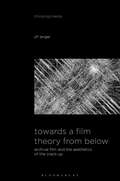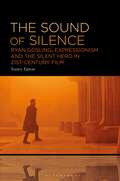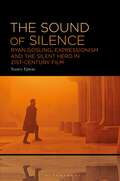- Table View
- List View
The Oneiric in the Films of David Lynch: A Phenomenological Approach
by Raphael MorschettThe Oneiric in the Films of David Lynch is the first systematic book-length study to explore the nature and function of dreams in David Lynch's different phases and audio-visual formats. There is hardly a contemporary film director whose name is as closely linked to the dream(-like) as that of David Lynch. Both popular and academic discourse frequently identify Lynch's films by their dreamlike qualities. However, in the existing literature on Lynch, these qualities tend to remain underspecified in terms of their experiential dimension. Departing from an interest in the phenomenon of dream experience, this is the first systematic book-length study exploring the nature and function of the oneiric in the director's different phases and audio-visual formats. It shows that, over the course of 50 years, Lynch has developed a cinematic aesthetics of the oneiric ? an ensemble of four dream-related dimensions that unfolds its full potential in the dynamic interplay between sensory address and reflective medialization. On the one hand, the Lynchian oneiric presents a markedly sensory-perceptual mode of experience – both characters and viewers are challenged in their perceptual patterns, while at the same time being immersed in the material dream scenario. On the other hand, the Lynchian oneiric provides a mode of both psychological and medial reflection. Not only the characters, but the films themselves are inclined to 'turn back' on themselves in a dream, exploring the preconditions, possibilities, and limitations of their own existence and ability to know the world. The oneiric in Lynch's films is thus of phenomenological, media-theoretical, and philosophical interest.
The Oneiric in the Films of David Lynch: A Phenomenological Approach
by Raphael MorschettThe Oneiric in the Films of David Lynch is the first systematic book-length study to explore the nature and function of dreams in David Lynch's different phases and audio-visual formats. There is hardly a contemporary film director whose name is as closely linked to the dream(-like) as that of David Lynch. Both popular and academic discourse frequently identify Lynch's films by their dreamlike qualities. However, in the existing literature on Lynch, these qualities tend to remain underspecified in terms of their experiential dimension. Departing from an interest in the phenomenon of dream experience, this is the first systematic book-length study exploring the nature and function of the oneiric in the director's different phases and audio-visual formats. It shows that, over the course of 50 years, Lynch has developed a cinematic aesthetics of the oneiric ? an ensemble of four dream-related dimensions that unfolds its full potential in the dynamic interplay between sensory address and reflective medialization. On the one hand, the Lynchian oneiric presents a markedly sensory-perceptual mode of experience – both characters and viewers are challenged in their perceptual patterns, while at the same time being immersed in the material dream scenario. On the other hand, the Lynchian oneiric provides a mode of both psychological and medial reflection. Not only the characters, but the films themselves are inclined to 'turn back' on themselves in a dream, exploring the preconditions, possibilities, and limitations of their own existence and ability to know the world. The oneiric in Lynch's films is thus of phenomenological, media-theoretical, and philosophical interest.
Towards a Film Theory from Below: Archival Film and the Aesthetics of the Crack-Up (Thinking Media)
by Jiri AngerOperating between film theory, media philosophy, archival practice, and audiovisual research, Jiri Anger focuses on the relationship between figuration and materiality in early films, experimental found footage cinema, and video essays. Would it be possible to do film theory from below, through the perspective of moving-image objects, of their multifarious details and facets, however marginal, unintentional, or aleatory they might be? Could we treat scratches, stains, and shakes in archival footage as speculatively and aesthetically generative features? Do these material actors have the capacity to create “weird shapes” within the figurative image that decenter, distort, and transform the existing conceptual and methodological frameworks?Building on his theoretical as well as practical experience with the recently digitized corpus of the first Czech films, created by Jan Kríženecký between 1898 and 1911, the author demonstrates how technological defects and accidents in archival films shape their aesthetic function and our understanding of the materiality of film in the digital age. The specific clashes between the figurative and material spheres are understood through the concept of a “crack-up.” This term, developed by Francis Scott Fitzgerald and theoretically reimagined by Gilles Deleuze, allows us to capture the convoluted relationship between figuration and materiality as inherent to the medium of film, containing negativity and productivity, difference and simultaneity, contingency and fate, at the same time, even within the tiniest cinematic units.
Towards a Film Theory from Below: Archival Film and the Aesthetics of the Crack-Up (Thinking Media)
by Jiri AngerOperating between film theory, media philosophy, archival practice, and audiovisual research, Jiri Anger focuses on the relationship between figuration and materiality in early films, experimental found footage cinema, and video essays. Would it be possible to do film theory from below, through the perspective of moving-image objects, of their multifarious details and facets, however marginal, unintentional, or aleatory they might be? Could we treat scratches, stains, and shakes in archival footage as speculatively and aesthetically generative features? Do these material actors have the capacity to create “weird shapes” within the figurative image that decenter, distort, and transform the existing conceptual and methodological frameworks?Building on his theoretical as well as practical experience with the recently digitized corpus of the first Czech films, created by Jan Kríženecký between 1898 and 1911, the author demonstrates how technological defects and accidents in archival films shape their aesthetic function and our understanding of the materiality of film in the digital age. The specific clashes between the figurative and material spheres are understood through the concept of a “crack-up.” This term, developed by Francis Scott Fitzgerald and theoretically reimagined by Gilles Deleuze, allows us to capture the convoluted relationship between figuration and materiality as inherent to the medium of film, containing negativity and productivity, difference and simultaneity, contingency and fate, at the same time, even within the tiniest cinematic units.
The Sound of Silence: Ryan Gosling, Expressionism and the Silent Hero in 21st-Century Film
by Nancy EptonThe Sound of Silence explores how non-verbal communication in film, shown primarily through the acting of Ryan Gosling, provides an expressive space in which passive audience viewing is made more active by removing the expository signifier of dialogue. The German Expressionist era may have been brief, but the shadows cast since its end nonetheless loom large. The silhouetted, cigar-wielding men of film noir and their respectively dark, doom-laden haunts mirror the angst-inducing atmospheres of their forebearers, while also introducing the now-familiar figure of the silent hero. Considering the numerous silent hero actors in film history, there's one that stands out in the 21st century like no other: Ryan Gosling. His later career has seen some of the most iconic silent heroes of the past decade, with films such as Drive, Only God Forgives, Blade Runner 2049 and First Man cementing him as the go-to guy for a monosyllabic, taciturn and moody hero whose actions speak louder than words. This book argues that it is Gosling's expressive capabilities that keep audiences compelled by his performances. With the use of non-verbal silence – combined with its counterbalance, sound – a more active, emotive audience response can be achieved. Looking further into this idea through theorists such as Michel Chion and Susan Sontag, the book demonstrates that the sound of silence is one of the most meaningful cinematic sounds of all.
The Sound of Silence: Ryan Gosling, Expressionism and the Silent Hero in 21st-Century Film
by Nancy EptonThe Sound of Silence explores how non-verbal communication in film, shown primarily through the acting of Ryan Gosling, provides an expressive space in which passive audience viewing is made more active by removing the expository signifier of dialogue. The German Expressionist era may have been brief, but the shadows cast since its end nonetheless loom large. The silhouetted, cigar-wielding men of film noir and their respectively dark, doom-laden haunts mirror the angst-inducing atmospheres of their forebearers, while also introducing the now-familiar figure of the silent hero. Considering the numerous silent hero actors in film history, there's one that stands out in the 21st century like no other: Ryan Gosling. His later career has seen some of the most iconic silent heroes of the past decade, with films such as Drive, Only God Forgives, Blade Runner 2049 and First Man cementing him as the go-to guy for a monosyllabic, taciturn and moody hero whose actions speak louder than words. This book argues that it is Gosling's expressive capabilities that keep audiences compelled by his performances. With the use of non-verbal silence – combined with its counterbalance, sound – a more active, emotive audience response can be achieved. Looking further into this idea through theorists such as Michel Chion and Susan Sontag, the book demonstrates that the sound of silence is one of the most meaningful cinematic sounds of all.



